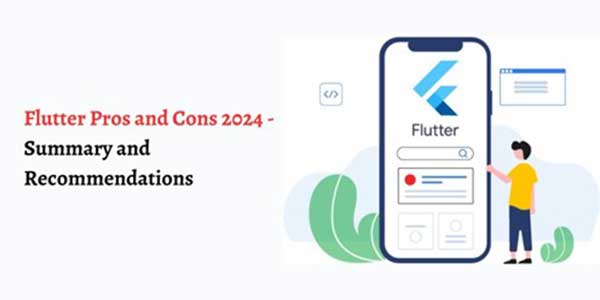
Businesses are rapidly investing in mobile app development. The reason is simple, it’s because the future of the modern world is digital and mobile-agnostic. Hence, investing in such strategies poses a long-term success. However, one of the major concerns these businesses face is whether to choose native development or cross-platform. In this case, a professional company recommends cross-platform development. It not only saves costs but also enables faster time-to-market. The best platform for this development mode is Flutter.
Furthermore, you can get assistance from an expert Flutter app development company to handle the end-to-end process. But before choosing this framework let us have a detailed overview including the pros and cons to help you make the right decision.
Table of Contents
An Overview Of Flutter:
Flutter is an open-source multi-platform framework and SDK. It was first released in 2017. It is built over the Dart programming language and follows the philosophy of writing code once and using the same code everywhere. It allows developers to build natively compiled applications from one codebase that can run over every device.
Additionally, it has a built-in set of rich customizable widgets and a hot reload feature for faster development and testing.
Developed by the tech giant Google, this framework saves the effort to rewrite code, as required in the case of native app development. Flutter uses Dart programming language, enhancing its performance and making the framework easy to use. Flutter offers a wide range of benefits that make it a powerful framework in cross-platform app development.
Pros And Cons Of Flutter App Development:
Every framework has various merits and demerits. Hence, it is up to your requirements, and based on that, you can identify the good and bad of a tech stack and then decide whether to choose it or not. Now, let us have a look at the pros and cons of Flutter in a nutshell.
Pros Of Flutter:
- Single Codebase For Multiple Platforms:
One of the main benefits of utilizing Flutter is keeping a solitary codebase while focusing on different stages. This implies that designers can compose their code once and use it to make applications for Android, iOS, web, and even work area conditions. Rather than depending on the local UI parts of every stage, Flutter utilizes its own gadgets and delivering motor, which guarantees a predictable look and feel across changed stages. The single codebase approach saves time and exertion and diminishes the possibilities of bugs and irregularities between stages.
The experts of a Flutter app development company can make updates and enhancements in one place, ensuring those changes are automatically reflected on all supported platforms.
- Hot Reload For Rapid Development:
Flutter offers a component known as “Hot Reload,” which is a unique advantage for one. Hot Reload permits one to make changes to their code and see the outcomes right away without recompiling the whole application or restarting it. This component decisively speeds up the development cycle, making exploring different avenues regarding different plan components and functionalities simpler. It’s a critical benefit for developers, as it empowers them to see the effect of their code changes progressively, improving efficiency.
- Highly Customizable User Interface:
It has a rich set of built-in customizable widgets, which gives the adaptability to make custom gadgets to suit the unique prerequisites of your application. This broad widget library guarantees that one can achieve almost any UI design or interaction they have in mind. With Flutter, you’re not restricted to the local parts of a particular platform and the firm offering Flutter application development services can create a UI that resonates with your brand image.
The freedom to create a highly customized user interface is invaluable, especially for organizations that need to thrive in the highly competitive application market. Whether making complex animations or designing a custom user interface, Flutter enables one to implement their creativity without any limitations.
- Consistent Multi-platform Performance:
Since it doesn’t depend on native components, it can offer consistent performance across various platforms. Applications developed with Flutter are known for their smooth and fluid animations, responsive UIs, and quick stacking times. Furthermore, Flutter’s capacity to arrange local ARM code for Android and iOS guarantees that your application can completely use the underlying platform’s capabilities. This results in applications that are not only visually appealing but also highly performant. Clients usually tend to engage with applications that give a consistent and pleasant experience, and this framework enables the firm offering Flutter app development services to create such experiences.
- Cost-Effective Development And Maintenance:
Cross-platform development intrinsically diminishes costs by permitting one to target multiple platforms with a solitary codebase. Flutter takes this cost-saving benefit further and assists with making feature-rich applications within budget. The efficiency of Flutter’s development process and robust features help expedite time to market and reduce development costs. Updates, bug fixes, and feature upgrades can be applied consistently across all platforms, reducing the burden of playing around with multiple codebases. This not only saves time but also minimizes the risk of introducing inconsistencies or bugs when making changes to the app.

Cons Of Flutter:
- Large App Size:
Flutter apps usually have a large app size as compared to the app size of a native application. For applications with strict size constraints, this could be a limiting factor.
- Limited Native Module Support:
Although Flutter provides a wide range of plugins and packages, there might be scenarios where a specific native module is required. In such cases, developers may need to write platform-specific code or rely on third-party plugins, which may not always be as reliable or up-to-date.
- Customization Challenges:
While Flutter’s widget library is extensive, there may be instances where developers face challenges customizing certain components to meet specific design requirements. In such cases, extensive modifications to the existing widgets or the creation of custom widgets may be necessary.
Final Words:
Flutter has emerged as a powerful tool for cross-platform development, offering a range of benefits that make it the ideal framework. It aligns with modern business requirements and enables the Flutter app development company to build a custom multi-platform application. If you are also looking to build a Flutter-based app, consider these pros and cons and create a strategy accordingly. Once you create a strategy, you can hire a development firm to handle your project.

 About the Author:
About the Author:
















Be the first to write a comment.